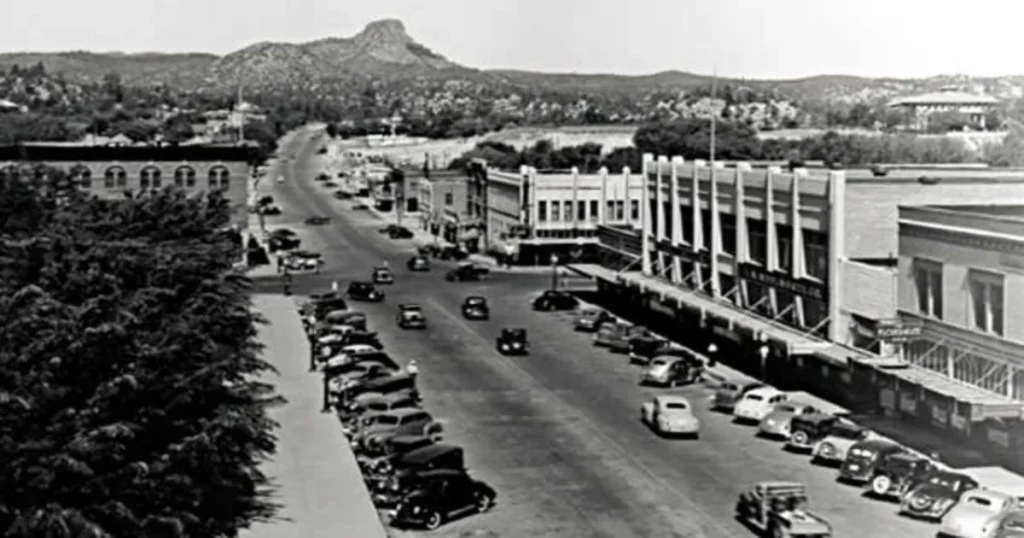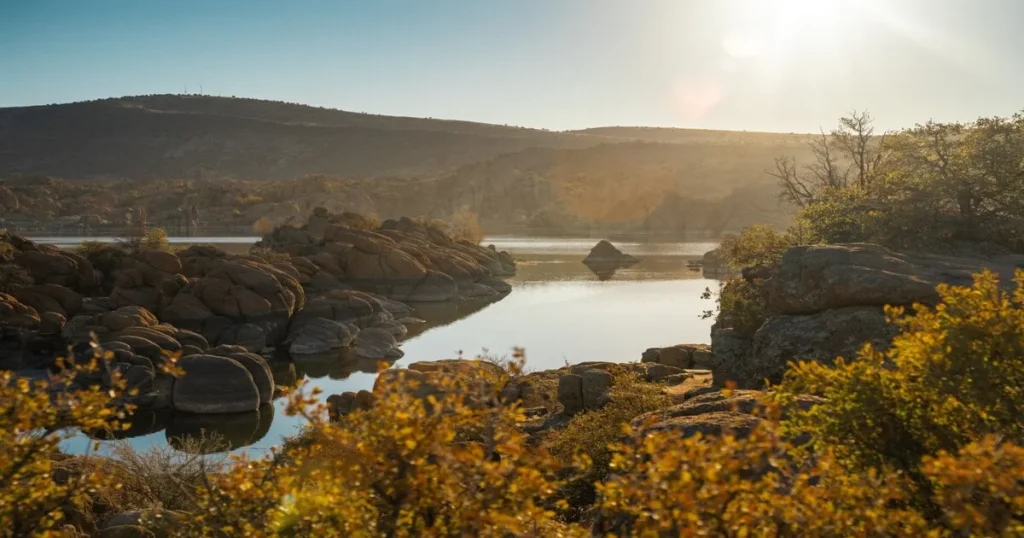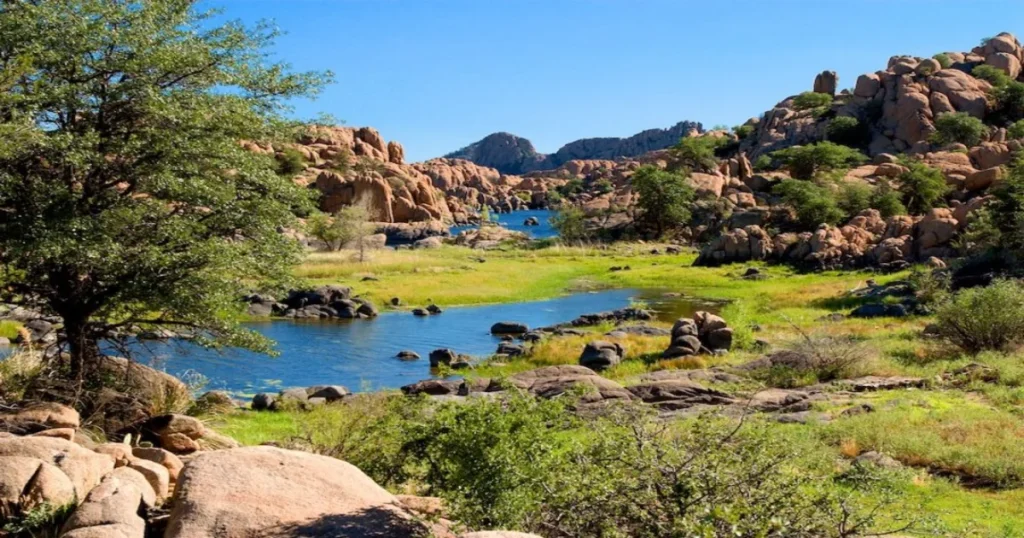Deep beneath the landscapes of Prescott lies a tapestry of tales dating back centuries. Stories of miners, families, communities, and the very earth that supported them. Throughout the years, Prescott’s mining legacy has been a testament to the strength and spirit of those who sought riches from its depths.
Yet, as the world shifts towards a more sustainable future, how does Prescott’s mining reconcile with today’s demands for environmentally friendly practices? In this article, we’ll delve deep into the history, the legacy, and most importantly, the future sustainability of mining in Prescott.

Prescott’s Historical Mining Landscape
Nestled amidst the scenic backdrop of Arizona, Prescott’s historical mining landscape tells a tale as old as the town itself. From the rugged terrains punctuated with early mining shafts to the remnants of gold rush era settlements, the landscape is a living museum of a bygone era.
These historical sites, some now reclaimed by nature and others preserved for posterity, stand as silent witnesses to the booms, busts, and relentless spirit of pioneers who sought fortune beneath the earth. A visit to Prescott offers more than just a glimpse into its mining past; it’s a journey through time, treading the paths once walked by miners, visionaries, and dreamers.
Origins of Mining in Prescott
In the mid-1800s, whispers of gold and other precious minerals led to an influx of pioneers looking to strike it rich in Prescott. While some found wealth, many more found a life interwoven with the complexities of mining and its challenges. Gold, silver, and copper became the town’s lifeblood, transforming it from a modest settlement into a bustling mining hub.
By the late 19th century, Prescott’s reputation had grown beyond Arizona, attracting miners from far and wide. These early days laid the foundation for the town’s rich mining culture, as detailed in the historical archives.
The Gold and Silver Rush Era
The Gold and Silver Rush era in Prescott is legendary. Between 1875 and 1885, the town witnessed an explosive growth in mining operations. Tales of vast fortunes being made overnight were not uncommon, and this drew thousands to the region.
Camps sprung up around mines, and communities formed. Yet, for all its prosperity, the rush also brought challenges. As mines expanded, so did the environmental footprint, an issue that would echo into the future. Interestingly, the Gold Rush wasn’t just about profit; it was also about the dreams and aspirations of those who ventured into the unknown. Historical records from the time offer a glimpse into their lives and motivations.
Economic and Social Impacts on the Community
Mining didn’t just shape the land; it shaped the people. Economically, Prescott transformed from a frontier town into a commercial center. Businesses sprouted, catering to the needs of miners and their families.
But it wasn’t all about money. Socially, a unique culture developed around mining. From festive gatherings to the formation of miners’ unions, the community became tightly knit. Sadly, it also had its share of tragedies, with mining accidents affecting many families.
But through it all, the resilience of Prescott’s community shone brightly. The economic and social impact of mining during these times is beautifully chronicled in Prescott’s Mining History.
Technological Evolution in Prescott’s Mining
The journey of mining in Prescott is as much about technological advancements as it is about extracting minerals. From the rudimentary tools of the early days to the sophisticated machinery of today, the evolution has been remarkable. This technological progress not only increased efficiency but also enhanced the safety and environmental standards of mining operations.
As the world advanced, Prescott’s mines seamlessly integrated innovations, ensuring that the town remained at the forefront of the industry’s evolution. Today, the marriage of tradition with cutting-edge technology continues to define and shape Prescott’s mining landscape.
Early Mining Techniques and Their Limitations
Initial mining endeavors were rather rudimentary. Pickaxes, shovels, and physical strength were the main assets of early miners. These methods, while effective for surface deposits, proved inefficient for deeper veins.

Moreover, the lack of safety equipment often made mining a perilous profession. Cave-ins, landslides, and other hazards were unfortunately all too common. Such challenges highlighted the need for more advanced techniques and safer practices.
Transition to Mechanized Mining
The dawn of the 20th century heralded a new era in mining technology. With the introduction of machinery like drills and dynamites, miners could now access previously unreachable deposits. This mechanization greatly boosted productivity. Yet, it also brought its set of challenges. The noise, dust, and disruption to the landscape were concerns that the community grappled with.
This transition, as documented by Mining Technology Journals, underscores the trade-offs between efficiency and environmental impact – a theme that resonates even today.
Modern Innovations and Efficiencies
Today, the mining landscape is almost unrecognizable from its early days. Advanced machinery, data analytics, and satellite imaging allow for precise, efficient extraction with minimal wastage.
While mining has undoubtedly fueled economic growth, it has also left an indelible mark on Prescott’s environment.
Landscape Alterations and Habitat Disruptions
Mines, by their very nature, alter landscapes. Hills were dug into, forests cleared, and water sources redirected. This had a cascading effect on local habitats. Flora and fauna that once thrived found themselves displaced or endangered.
Such disruptions weren’t just confined to the immediate vicinity of the mines. The transportation of ores, establishment of settlements, and other ancillary activities further compounded the environmental strain.
Water Quality Challenges
Mining operations, especially in the early days, posed significant challenges to water quality. Runoffs from mines often carried with them heavy metals and other contaminants, polluting streams and groundwater.
Over time, as the community grew increasingly aware of these challenges, efforts were made to mitigate them. However, the legacy of past practices still lingers, with some water sources in the region showing traces of contamination.
Air Quality and Dust Issues
Air quality too bore the brunt of mining activities. Dust from mining operations, especially during the era of mechanized mining, became a significant concern. Not only did it pose respiratory risks to miners, but it also affected the broader community.
Initiatives like dust suppression and the use of greener machinery have been instrumental in addressing these challenges. The Environmental Protection Agency’s guidelines have played a crucial role in shaping these practices.
Labor and Mining in Prescott’s History
Labor has been the heartbeat of Prescott’s mining chronicles. From the early pioneers who braved harsh conditions to extract precious minerals, to the rise of labor movements advocating for miners’ rights and safety, the story is one of grit, determination, and evolution.
Over the decades, as the town grew around its mines, the narrative shifted from mere extraction to recognizing and honoring the invaluable contributions of its workers. Today, modern labor practices in Prescott stand as a testament to this storied history, echoing the sacrifices and triumphs of miners who laid the town’s foundational stones.
The Role of Miners in the Early Days
Miners in Prescott’s early days were a tenacious lot. Braving the elements, they ventured deep into the earth, often with little more than a lantern to light their way. The physical and mental demands of the job forged a unique bond among them.
Yet, it wasn’t all hardship. Miners also found camaraderie and joy in their shared experiences. Their tales of discovery, bravery, and camaraderie echo through the annals of Prescott’s history. These pioneers, with their indomitable spirit, played a pivotal role in shaping the town’s identity.
Labor Movements and Worker Rights
As mining operations grew, so did the realization of better working conditions and rights for miners. The late 19th and early 20th centuries saw the rise of labor movements in Prescott. These movements fought for safer working conditions, fair wages, and the recognition of miners’ invaluable contributions.

Unions were formed, strikes were organized, and over time, the voices of the miners began to resonate with the industry’s decision-makers. This era was pivotal in establishing the rights and benefits that modern miners enjoy today. Their struggles and triumphs are well documented in Prescott’s labor movement chronicles.
Modern-Day Labor Practices and Safety Standards
The sacrifices and efforts of the early miners did not go in vain. Today, the mining industry in Prescott is synonymous with stringent safety standards, advanced training programs, and a commitment to worker well-being.
Modern mines are equipped with state-of-the-art safety equipment, regular health check-ups are mandated, and miners are trained to handle emergencies. Furthermore, miners today have a voice, thanks to established unions and worker councils.
They play an active role in decision-making processes, ensuring that their rights are always upheld. Modern labor practices in mining shed light on how far the industry has come in terms of worker welfare.
The Socio-economic Tapestry of Prescott’s Mining Community
The mining endeavors in Prescott did more than just extract minerals; they shaped a vibrant socio-economic community. As mines thrived, so did towns around them, blossoming into hubs of commerce, education, and culture.
This growth fostered an intricate tapestry of relationships, institutions, and traditions, deeply rooting mining families across generations.
The very essence of Prescott’s communal identity, from its bustling towns to its educational establishments, owes much to the legacy of its mining heritage, underlining the profound and lasting impact of the industry on the town’s societal framework.
Rise of Mining Towns and Their Influence
The surge in mining led to the rapid development of several towns around Prescott. These towns, initially set up to support mining operations, soon became vibrant hubs of commerce and culture.
Shops, schools, entertainment centers, and churches sprang up, each narrating a unique story of community life during the mining boom. These towns, with their distinct character, became integral to Prescott’s identity. Many of them, like Jerome and Crown King, continue to celebrate their mining heritage through festivals, museums, and tours.
Educational and Social Institutions Stemming from Mining
With the prosperity that mining brought, there was a renewed focus on education and community welfare. Several schools and colleges were established, some of which stand to this day as testimonies to Prescott’s commitment to knowledge and growth.
Additionally, social clubs, recreational centers, and community halls became commonplace. These institutions played a crucial role in fostering camaraderie and a sense of belonging among the residents. The history of Prescott’s educational and social institutions offers a deep dive into their formation and significance.
Transition of Mining Families and Generational Impact
Mining wasn’t just a job; it was a way of life that spanned generations. Families deeply rooted in mining passed down stories, values, and often, the very profession, from one generation to the next.
While some continued in their forefathers’ footsteps, others branched out, using the skills and values instilled by their mining heritage to excel in diverse fields. This transition of mining families and their evolution forms a riveting chapter in Prescott’s socio-economic narrative.
Prescott’s Mining in Literature, Art, and Culture
Prescott’s mining heritage is intricately woven into its cultural fabric, leaving an indelible mark on its literature, art, and broader cultural expressions. Tales of the mines have found their way into poignant literature, capturing the essence of an era, while artists have immortalized the rugged landscapes and daily life of miners on canvas.
This intertwining of mining with artistic and literary endeavors not only pays tribute to Prescott’s past but also ensures that its rich history continues to inspire and resonate with future generations.
Stories and Poems: Life in the Mines
Literature from the mining era paints a vivid picture of life in and around the mines. From tales of harrowing adventures to heartwarming anecdotes of camaraderie, these stories and poems offer a window into a bygone era.
Local authors, inspired by real-life experiences, penned down emotions, challenges, and joys that resonated with everyone associated with mining. Their works are a rich resource for anyone keen on exploring Prescott’s literary legacy.
Visual Representations: Paintings and Photographs
Beyond the written word, Prescott’s mining heritage has been immortalized in paintings, sketches, and photographs. Artists, both local and those drawn to the town’s vibrant history, captured moments ranging from the daily grind of miners to the sprawling landscapes dotted with mines.
Early photographs, especially, provide an authentic glimpse into the mining operations, the people, and the evolving townscapes. Galleries such as the Prescott Art Museum often host exhibitions showcasing these visual treasures.
Modern-Day Artistic Interpretations and Commemorations
Today, contemporary artists, inspired by Prescott’s mining legacy, are creating modern interpretations through various mediums. Sculptures, digital art, music, and theater productions celebrate the town’s rich history while drawing parallels to current global themes.
Annual festivals, art installations, and community projects ensure that the legacy is not just remembered but also relived, allowing newer generations to connect with their roots. Events celebrating Prescott’s mining heritage are a testament to the town’s undying connection with its past.
Future Sustainability in Prescott’s Mining
As the world becomes increasingly aware of environmental concerns, Prescott’s mining industry faces a pivotal moment in its storied history. Balancing its rich legacy with the imperatives of modern-day sustainability, Prescott is forging a path that merges respect for its past with responsibility for the future.
Leveraging green mining technologies and community-driven initiatives, the town is setting a gold standard for how mining can evolve to meet the challenges of the 21st century, ensuring that its legacy remains both prosperous and environmentally conscious.
The Need for Sustainable Practices
The adverse environmental impacts of traditional mining practices are undeniable. As awareness grows, there’s an increasing demand for mining operations that are both profitable and environmentally responsible.
Prescott, with its deep-rooted mining culture, is uniquely positioned to lead this change. The community’s intrinsic connection with the land drives the pursuit of practices that protect and preserve it for future generations.
Green Mining Technologies and Initiatives
The push for sustainability has ushered in a new era of green mining technologies. These include water-saving techniques, waste-reduction methods, and the use of renewable energy in mining operations.
Companies are also exploring biotechnologies to extract minerals without the need for harmful chemicals. Such initiatives not only reduce the environmental footprint but also make mining more cost-effective in the long run. Green mining innovations are setting the course for a brighter, more sustainable future for the industry.
Community Participation in Sustainable Mining
At the heart of Prescott’s sustainable mining initiatives is the community. Residents, many of whom have deep ties to mining, are actively involved in decision-making processes, ensuring that sustainability isn’t just an industry buzzword, but a lived reality.
Community-driven projects focus on rehabilitating mined lands, preserving local biodiversity, and promoting eco-tourism. This collaborative approach has fostered a strong bond between the mining industry and the people, making sustainability a collective endeavor. Community-led sustainability initiatives in Prescott are leading examples for other mining regions globally.
Educating the Next Generation
The path to a sustainable future lies in educating the next generation. Schools and institutions in Prescott are incorporating lessons on sustainable mining, emphasizing its importance in today’s world.

Field trips, workshops, and interactive sessions with industry professionals offer students a first-hand experience of modern mining practices. By ingraining the principles of sustainability early on, Prescott ensures that its future custodians carry forth the legacy responsibly. Education initiatives in sustainable mining highlight the town’s commitment to nurturing informed and conscious citizens.
Frequently Asked Questions:
In this section, we will be delving into some of the most common inquiries and curiosities that surround our topic.
What role has mining played in Prescott’s development?
Mining has been the backbone of Prescott’s economic and cultural development. From its inception in the 1860s, it has influenced the town’s growth, shaping its socio-economic landscape and infusing it with a rich cultural tapestry.
How has mining influenced Prescott’s art and literature?
Mining has left an indelible mark on Prescott’s artistic and literary scenes. From poignant tales of life in the mines to visual masterpieces depicting the mining landscape, the influence is evident and celebrated.
Is modern-day mining in Prescott sustainable?
Yes, there’s a concerted effort to ensure that mining practices in Prescott are sustainable. Green technologies, community participation, and educational initiatives are driving this shift toward a more responsible mining future.
Conclusion: For Prescott’s mining legacy and its future sustainability
Prescott’s mining legacy is a tapestry of tales, triumphs, and transitions. From its early days of rugged pioneers to modern practices that champion sustainability, the town stands as a testament to the human spirit’s ability to adapt and evolve.
As we delve deep into its rich history, we also gaze ahead, hopeful that Prescott continues to balance its cherished legacy with the imperatives of a sustainable future. This journey, marked by resilience and innovation, will undoubtedly inspire generations to come.



Leave a Comment
You must be logged in to post a comment.